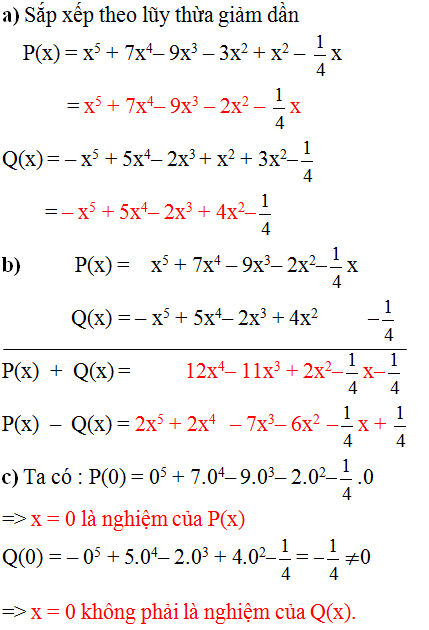Hãy nhập câu hỏi của bạn vào đây, nếu là tài khoản VIP, bạn sẽ được ưu tiên trả lời.

\(f\left(x\right)=2x+1=0\)
\(\Leftrightarrow\)\(x=-\frac{1}{2}\)
\(g\left(x\right)=x^3+\frac{1}{2}x^2+3x+\frac{3}{2}=0\)
\(\Leftrightarrow\)\(x^2\left(x+\frac{1}{2}\right)+3\left(x+\frac{1}{2}\right)=0\)
\(\Leftrightarrow\)\(\left(x+\frac{1}{2}\right)\left(x^2+3\right)=0\)
\(\Leftrightarrow\)\(x+\frac{1}{2}=0\) (vì x2 + 3 > 0 )
\(\Leftrightarrow\)\(x=-\frac{1}{2}\)
Vậy nghiệm chung là: \(x=-\frac{1}{2}\)

\(\left\{\begin{matrix}f\left(x\right)=x^5+7x^4-9x^3-2x^2-\dfrac{1}{4}x\left(1\right)\\g\left(x\right)=-x^5+5x^4-2x^3+4x^2-\dfrac{1}{4}\left(2\right)\end{matrix}\right.\)
Sắp xếp số mũ của (ẩn theo một trình tự, Thường, nên giảm dần"
Tính f(x)+g(x) lấy (1) cộng (2)
\(f\left(x\right)+g\left(x\right)=\left(1-1\right)x^5+\left(7+5\right)x^4+\left(-9-2\right)x^3+\left(-2+4\right)x^2+\left(-\dfrac{1}{4}\right)x+\left(-\dfrac{1}{4}\right)\)
\(f\left(x\right)+g\left(x\right)=12x^4-11x^3+2x^2-\dfrac{1}{4}x-\dfrac{1}{4}\)
Tính f(x)-g(x) lấy (1) trừ (2)
\(f\left(x\right)-g\left(x\right)=2x^5+2x^4-7x^3-6x^2-\dfrac{1}{4}x+\dfrac{1}{4}\)

a. P(x)+Q(x)=(3x4 + x3- x2- \(\dfrac{1}{4}\)x)+(3x4- 4x3+x2-\(\dfrac{1}{4}\))=6x4-3x3+\(\dfrac{1}{2}\)
Tương tự làm P(x)-Q(X) nhé !!!
b. Thay x = 0 vào đa thức P(x) ta có :
.....................................................
thay x = 0 vào đa thức Q(x) ta có:
......................................................
=> đpcm

I . Trắc Nghiệm
1B . 2D . 3C . 5A
II . Tự luận
2,a,Ta có: A+(x\(^2\)y-2xy\(^2\)+5xy+1)=-2x\(^2\)y+xy\(^2\)-xy-1
\(\Leftrightarrow\) A=(-2x\(^2\)y+xy\(^2\)-xy-1) - (x\(^2\)y-2xy\(^2\)+5xy+1)
=-2x\(^2\)y+xy\(^2\)-xy-1 - x\(^2\)y+2xy\(^2\)-5xy-1
=(-2x\(^2\)y - x\(^2\)y) + (xy\(^2\)+ 2xy\(^2\)) + (-xy - 5xy ) + (-1 - 1)
= -3x\(^2\)y + 3xy\(^2\) - 6xy - 2
b, thay x=1,y=2 vào đa thức A
Ta có A= -3x\(^2\)y + 3xy\(^2\) - 6xy - 2
= -3 . 1\(^2\) . 2 + 3 .1 . 2\(^2\) - 6 . 1 . 2 -2
= -6 + 12 - 12 - 2
= -8
3,Sắp xếp
f(x) =9-x\(^5\)+4x-2x\(^3\)+x\(^2\)-7x\(^4\)
=9-x\(^5\)-7x\(^4\)-2x\(^3\)+x\(^2\)+4x
g(x) = x\(^5\)-9+2x\(^2\)+7x\(^4\)+2x\(^3\)-3x
=-9+x\(^5\)+7x\(^4\)+2x\(^3\)+2x\(^2\)-3x
b,f(x) + g(x)=(9-x\(^5\)-7x\(^4\)-2x\(^3\)+x\(^2\)+4x) + (-9+x\(^5\)+7x\(^4\)+2x\(^3\)+2x\(^2\)-3x)
=9-x\(^5\)-7x\(^4\)-2x\(^3\)+x\(^2\)+4x-9+x\(^5\)+7x\(^4\)+2x\(^3\)+2x\(^2\)-3x
=(9-9)+(-x\(^5\)+x\(^5\))+(-7x\(^4\)+7x\(^4\))+(-2x\(^3\)+2x\(^3\))+(x\(^2\)+2x\(^2\))+(4x-3x)
= 3x\(^2\) + x
g(x)-f(x)=(-9+x\(^5\)+7x\(^4\)+2x\(^3\)+2x\(^2\)-3x) - (9-x\(^5\)-7x\(^4\)-2x\(^3\)+x\(^2\)+4x)
=-9+x\(^5\)+7x\(^4\)+2x\(^3\)+2x\(^2\)-3x-9+x\(^5\)+7x\(^4\)+2x \(^3\)-x\(^2\)-4x
=(-9-9)+(x\(^5\)+x\(^5\))+(7x\(^4\)+7x\(^4\))+(2x\(^3\)+2x\(^3\))+(2x\(^2\)-x\(^2\))+(3x-4x)
= -18 + 2x\(^5\) + 14x\(^4\) + 4x\(^3\) + x\(^2\) - x

câu a) \(A=3x^3+7x^2+3x-\left(\dfrac{1}{4}+3x^3\right)-3\dfrac{3}{4}\)
\(\Leftrightarrow A=3x^3+7x^2+3x-\dfrac{1}{4}-3x^3-\dfrac{15}{4}\)
\(\Leftrightarrow A=7x^2+3x-4\)
\(B=x\left(x^2-x+1\right)-\dfrac{1}{2}x^2\left(2x-4\right)-2\)
\(\Leftrightarrow B=x^3-x^2+x-x^3+2x^2-2\)
\(\Leftrightarrow B=x^2+x-2\)
câu b) chỉ cần thế \(x=-1\) vào biểu thức \(A\) \(\Rightarrow\) tính
và thế \(x=\dfrac{1}{2}\) vào biểu thức \(B\) \(\Rightarrow\) tính
câu c) ta có \(B+M=A\Leftrightarrow x^2+x-2+M=7x^2+3x-4\)
\(\Leftrightarrow M=7x^2+3x-4-\left(x^2+x-2\right)=6x^2+2x-2\)
câu d) ta có : \(\dfrac{x+5}{-3}=\dfrac{x}{2}\Leftrightarrow2\left(x+5\right)=-3x\Leftrightarrow2x+10=-3x\)
\(\Leftrightarrow5x=-10\Leftrightarrow x=-2\)
thế \(x=-2\) vào \(M=6x^2+2x-2=6.\left(-2\right)^2+2\left(-2\right)-2=18\)

tìm nghiệm của đa thức sau:
a,\(\left(-\dfrac{5}{3}x^2+\dfrac{3}{5}\right)\left(x^2-2\right)\)
Xét \(\left(-\dfrac{5}{3}x^2+\dfrac{3}{5}\right)\left(x^2-2\right)\) \(=0\)
\(\Leftrightarrow\left[{}\begin{matrix}-\dfrac{5}{3}x^2+\dfrac{3}{5}=0\\x^2-2=0\end{matrix}\right.\)
\(\Leftrightarrow\left[{}\begin{matrix}-\dfrac{5}{3x}x^2=-\dfrac{3}{5}\\x^2=2\end{matrix}\right.\)
\(\Leftrightarrow\left[{}\begin{matrix}x^2=\dfrac{9}{25}\\\left[{}\begin{matrix}x=-\sqrt{2}\\x=\sqrt{2}\end{matrix}\right.\end{matrix}\right.\)
\(\Leftrightarrow\left[{}\begin{matrix}\left[{}\begin{matrix}x=\dfrac{9}{25}\\x=-\dfrac{9}{25}\end{matrix}\right.\\\left[{}\begin{matrix}x=\sqrt{2}\\x=-\sqrt{2}\end{matrix}\right.\end{matrix}\right.\)
Vậy nghiệm của đa thức \(\left(-\dfrac{5}{3}x^2+\dfrac{3}{5}\right)\left(x^2-2\right)\) là \(\left\{\dfrac{9}{25};-\dfrac{9}{25};\sqrt{2};-\sqrt{2}\right\}\)

a: \(h\left(x\right)=f\left(x\right)+g\left(x\right)=x^3-x^2+x-24\)
Bậc là 3
b: \(k\left(x\right)=f\left(x\right)-g\left(x\right)=7x^3-9x^2+11x+6\)
\(g\left(\dfrac{3}{2}\right)=-3\cdot\dfrac{27}{8}+4\cdot\dfrac{9}{4}-5\cdot\dfrac{3}{2}-15=-\dfrac{189}{8}\)
\(k\left(\dfrac{3}{2}\right)=7\cdot\dfrac{27}{8}-9\cdot\dfrac{9}{4}+11\cdot\dfrac{3}{2}+6=\dfrac{207}{8}\)

I . Trắc Nghiệm 1B . 2D . 3C . 5A II . Tự luận 2,a,Ta có: A+(x22y-2xy22+5xy+1)=-2x22y+xy22-xy-1 ⇔⇔ A=(-2x22y+xy22-xy-1) - (x22y-2xy22+5xy+1) =-2x22y+xy22-xy-1 - x22y+2xy22-5xy-1 =(-2x22y - x22y) + (xy22+ 2xy22) + (-xy - 5xy ) + (-1 - 1) = -3x22y + 3xy22 - 6xy - 2 b, thay x=1,y=2 vào đa thức A Ta có A= -3x22y + 3xy22 - 6xy - 2 = -3 . 122 . 2 + 3 .1 . 222 - 6 . 1 . 2 -2 = -6 + 12 - 12 - 2 = -8 3,Sắp xếp f(x) =9-x55+4x-2x33+x22-7x44 =9-x55-7x44-2x33+x22+4x g(x) = x55-9+2x22+7x44+2x33-3x =-9+x55+7x44+2x33+2x22-3x b,f(x) + g(x)=(9-x55-7x44-2x33+x22+4x) + (-9+x55+7x44+2x33+2x22-3x) =9-x55-7x44-2x33+x22+4x-9+x55+7x44+2x33+2x22-3x =(9-9)+(-x55+x55)+(-7x44+7x44)+(-2x33+2x33)+(x22+2x22)+(4x-3x) = 3x22 + x g(x)-f(x)=(-9+x55+7x44+2x33+2x22-3x) - (9-x55-7x44-2x33+x22+4x) =-9+x55+7x44+2x33+2x22-3x-9+x55+7x44+2x 33-x22-4x =(-9-9)+(x55+x55)+(7x44+7x44)+(2x33+2x33)+(2x22-x22)+(3x-4x) = -18 + 2x55 + 14x44 + 4x33 + x22 - x


Lời giải:
\(f(x)=2x+1\)
\(g(x)=x^3+\frac{1}{2}x^2+3x+\frac{3}{2}\)
\(=x^2(x+\frac{1}{2})+3(x+\frac{1}{2})\)
\(=(x^2+3)(x+\frac{1}{2})=\frac{1}{2}(x^2+3)(2x+1)\)
Do đó $f(x),g(x)$ có chung nhân tử \(2x+1\) nên có chung nghiệm \(x=-\frac{1}{2}\)